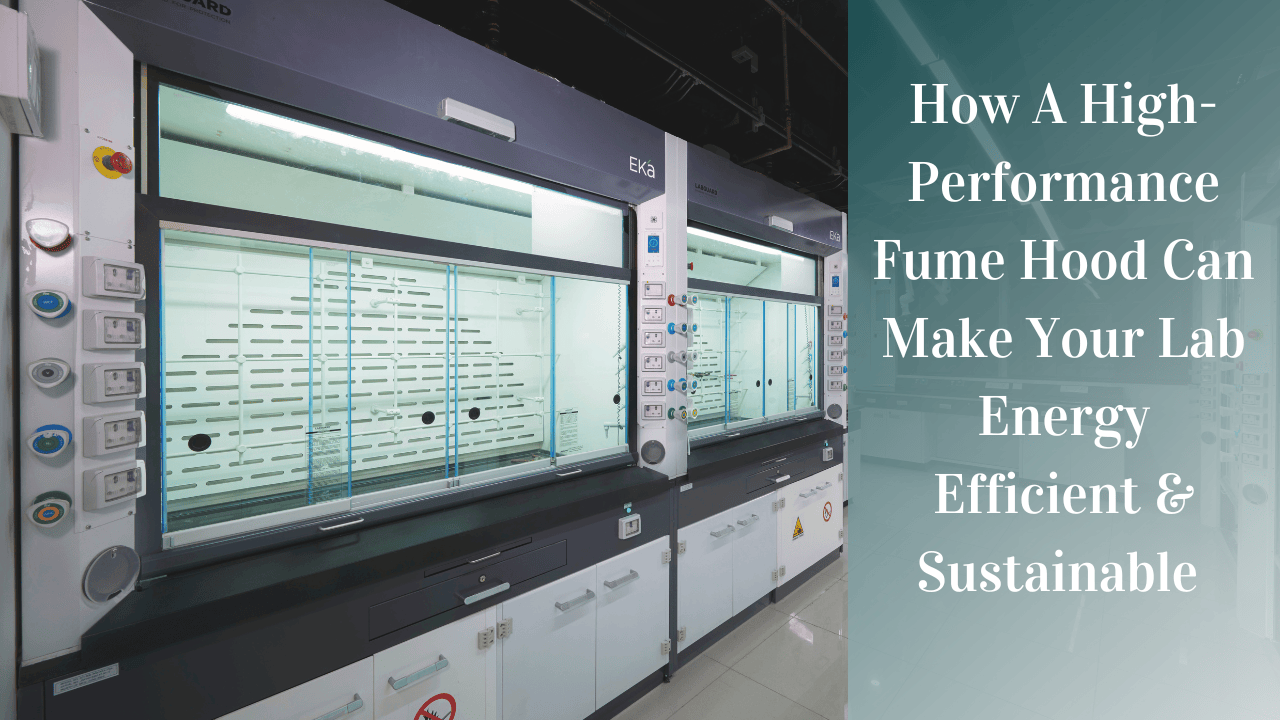Contents
- Introduction
- Understanding High Performance Fume Hoods
- Multiple definitions of High Performance
- The ASHRAE 110 Test
- What makes a Fume Hood High Performance
- Approaches to Containment, Safety, and Energy Efficiency
- Overcoming barriers to efficience
- Empowering researchers: Balancing safety and sustainability
- LabGuard’S commitment to energy-efficient fume hoods
- Conclusion
Introduction
As pioneers in the field of laboratory equipment and the driving force behind empowering researchers, LabGuard is committed to bringing cutting-edge solutions for sustainable and efficient lab practices. In this article, we shed light on the significance of high-performance fume hoods and their impact on energy use and savings potential in laboratories. Let’s delve into the details to discover how a well-engineered fume hood can make a difference in laboratory sustainability.
Understanding High-Performance Fume Hoods
Due to the variety of similar terms and definitions in the industry, high-performance fume hoods, also known by numerous names, can cause misunderstanding. We refer to the Scientific Equipment and Furniture Association (SEFA) criteria, which establishes the minimal need for high-efficiency fume hoods, to help explain the idea. These hoods may be referred to as energy-efficient, high-efficiency, low-velocity, low-flow, or low-exhaust hoods. All of these phrases, however, necessitate adherence to the strict efficiency requirements of the SEFA.The following is the definition of an Energy Efficient fume hood provided by the Scientific Equipment and Furniture Association (SEFA):
“Low Velocity Laboratory Fume Hoods are hood designs that provide a reduction in the required exhaust air volume, compared to the volume required for the same size fume hood operating with a face velocity of 100 FPM through a fully opened vertical sash. These hoods must also provide containment levels equivalent or superior to ASHRAE 110:2016 tracer gas test ratings of 4.0 AM 0.05 and 4.0 AI/AU 0.10, with a face velocity of 60 FPM or less through the fully opened vertical sash. These hoods are also known as High-Performance Fume Hoods and High-Efficiency Fume Hoods.” (SEFA Desk Reference Illustrated, 4th Edition, Version 1.0, 2010)
The ASHRAE 110 : 2016 Test
The ASHRAE 110 test is a crucial evaluation method for high-performance fume hoods. Comprised of three parts, this test helps measure the fume hood’s containment capabilities.
Face Velocity Scan
This scan measures the airflow velocity at various points on the fume hood face, ensuring uniform airflow distribution for optimal safety.
Smoke Visualization Test
Smoke is introduced into the hood to visualize airflow patterns and identify potential turbulence, which can compromise containment.
Sulfur Hexafluoride Containment Test
In this evaluation, a tracer gas called sulfur hexafluoride (SF6) is introduced into the fume hood. A mannequin resembling a human shape is positioned inside the hood with sensors to detect the presence of SF6 tracer gas near its chest and face. The outcomes of this test assess the hood’s efficiency in safely containing hazardous substances.
What Makes a Fume Hood High Performance?
While meeting the SEFA definition is the baseline for high performance, some fume hoods go above and beyond, demonstrating higher efficiency than others. The face velocity of a fume hood plays a pivotal role, and while there is no universal magic number, standards specify a range. This range takes into account the advancements in hood design and technology, ensuring that face velocity is optimized for superior user protection and energy efficiency.
Approaches to Containment, Safety, and Energy Efficiency
Several design strategies have been employed to reduce fume hood energy use. These include introducing tempered outdoor air near the hood’s face,
Using dampers and variable speed ventilation, and Restricting the hood’s face opening while maintaining a constant airflow.
These approaches aim to strike the right balance between user protection and efficient energy utilization.
Empowering Researchers with Energy Savings
At LabGuard, we recognize that lab planners strive for optimal user protection without compromising on energy efficiency. High-performance fume hoods serve as a cornerstone for achieving these dual goals. By investing in well-engineered fume hoods, laboratories can ensure their researchers work in a safe and sustainable environment, driving progress while reducing energy consumption and costs.
Balancing Safety and Sustainability
The path to a greener future lies in balancing safety and sustainability. High-performance fume hoods perfectly harmonise both, providing researchers with cutting-edge protection while minimizing energy usage. This balanced approach not only enhances the well-being of lab personnel but also contributes to the more significant cause of environmental responsibility.
LabGuard’s Commitment to High Performance
As the experts in fume hoods and laboratory solutions, LabGuard takes pride in offering India’s first high-performance fume hood, Eka. Eka is not just a piece of equipment; it represents our unwavering commitment to empowering researchers with the best-in-class safety, energy efficiency, and elegance. With Eka, laboratories can optimize their operations, maximize energy savings, and achieve new possibilities in their quest for scientific advancement.
Conclusion
In the world of laboratory design and safety, high-performance fume hoods are a beacon of excellence. They embody LabGuard’s core values of empowerment and innovation, safeguarding researchers while promoting sustainable lab practices. By investing in a well-engineered fume hood like Eka, laboratories can unlock the true potential of safety, energy efficiency, and breakthrough research.


